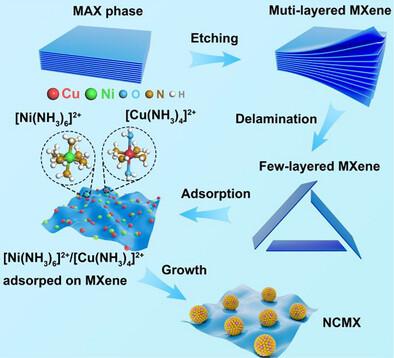Enhanced Sodium Polysulfide Adsorption by In Situ Construction of NiS2/Cu2S Heterointerfaces and Sulfur Vacancies Enabling High‐Performance Sodium Storage
IF 12.1
2区 材料科学
Q1 CHEMISTRY, MULTIDISCIPLINARY
引用次数: 0
Abstract
Nickel disulfides have been actively investigated as sodium‐ion battery anode materials because of their relatively high capacity and relatively low cost. However, their practical application is severely hindered by overcharge failure in ether‐based electrolytes induced by the dissolution of sodium polysulfides. Herein, sulfur vacancy‐rich NiS

原位构建NiS2/Cu2S异质界面和硫空位增强多硫化钠吸附,实现高性能钠储存
二硫化镍因其相对较高的容量和相对较低的成本而成为钠离子电池负极材料的研究热点。然而,由于多硫化钠溶解引起的乙基电解质过充电失效,严重阻碍了它们的实际应用。本文通过简单的溶剂热法合成了锚定在Ti3C2Tx MXene纳米片(NCMX)上的富含硫空位的NiS2/Cu2S异质结纳米簇。密度泛函理论计算结合非原位表征表明,硫空位显著增强了多硫化物钠的吸附,而异质界面诱导的内置电场促进了Na⁺的快速吸附,从而加速了Na⁺向Na2S的有效转化。协同效应使NCMX阳极具有优异的钠离子存储性能。它提供了卓越的可逆容量(668 mAh g - 1, 0.1 A g - 1),极好的速率能力(482 mAh g - 1, 5 A g - 1),和令人印象深刻的循环稳定性(543 mAh g - 1, 1000次循环后,1 A g - 1的容量衰减为0.0034%)。这种同时构建异质结和硫空位的策略为解决多硫化物穿梭问题,设计先进的高性能过渡金属二硫阳极用于钠离子存储铺平了新的途径。
本文章由计算机程序翻译,如有差异,请以英文原文为准。
求助全文
约1分钟内获得全文
求助全文
来源期刊

Small
工程技术-材料科学:综合
CiteScore
17.70
自引率
3.80%
发文量
1830
审稿时长
2.1 months
期刊介绍:
Small serves as an exceptional platform for both experimental and theoretical studies in fundamental and applied interdisciplinary research at the nano- and microscale. The journal offers a compelling mix of peer-reviewed Research Articles, Reviews, Perspectives, and Comments.
With a remarkable 2022 Journal Impact Factor of 13.3 (Journal Citation Reports from Clarivate Analytics, 2023), Small remains among the top multidisciplinary journals, covering a wide range of topics at the interface of materials science, chemistry, physics, engineering, medicine, and biology.
Small's readership includes biochemists, biologists, biomedical scientists, chemists, engineers, information technologists, materials scientists, physicists, and theoreticians alike.
 求助内容:
求助内容: 应助结果提醒方式:
应助结果提醒方式:


